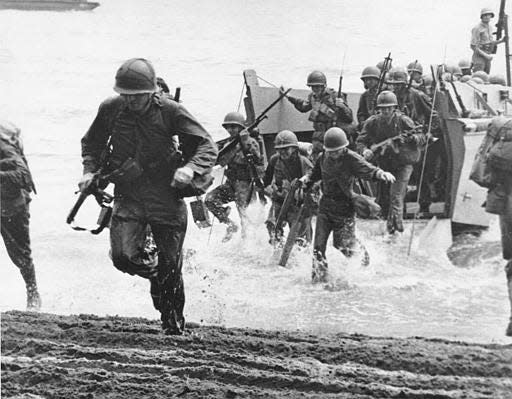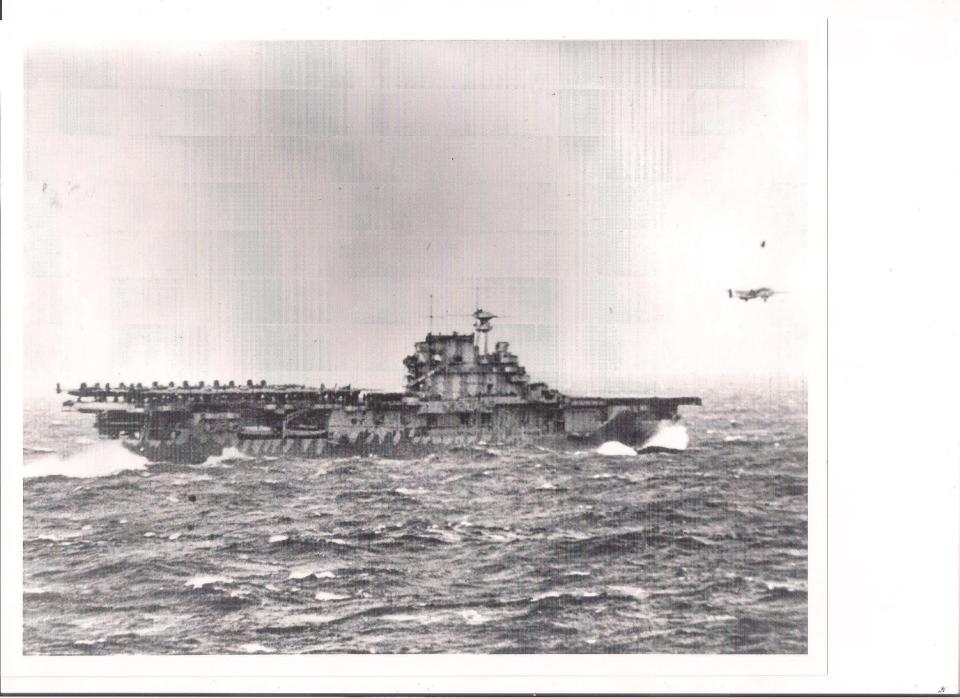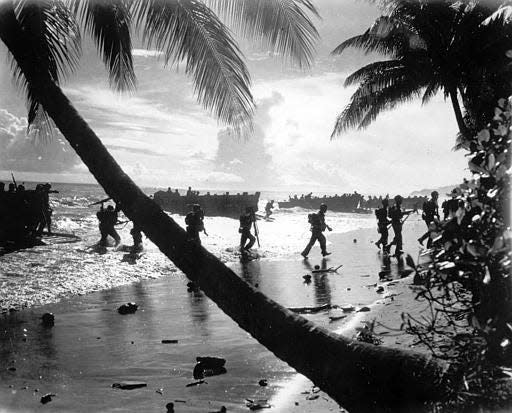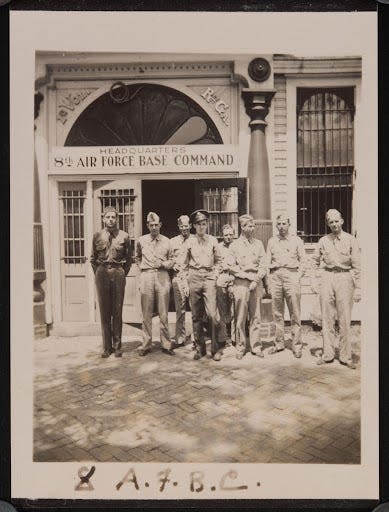Eighty years ago, the world outlook was bleak. Enter America into WW II, and fortunes turned
As America marks Veterans Day, think back to 80 years ago. It is just after the devastating December 7, 1941 Japanese surprise attack on Pearl Harbor that thrust the United States into World War II.
The first few months of the war were a disaster for the Americans, and the hope of victory seemed like a pipe dream. Only a small percentage of Americans now appreciate the very bleak wartime situation the country faced at the beginning of 1942. No one could have imagined that situation would be totally transformed by the end of 1942.
Militarism and authoritarianism were ascendant in the world when 1942 began. Had democracy had its day?
80 years ago: The Doolittle Raid marked the day we knew we could win WWII

World on the brink
A status report in the spring of 1942 would show the German Army had conquered almost all of Western Europe along with its resources. Thanks to the heroism of the Royal Air Force during the London Blitz and Battle Of Britain, the British had stymied a German invasion, but were precariously hanging on for survival.
Japan had wiped out the colonial presence of the United States, Great Britain, and France in the Western Pacific and East Asia in only a few months and was seriously threatening Australia and India.
The Axis powers (Germany, Italy, and Japan) had conquered huge empires that gave them access to tremendous amounts of natural resources, such as oil, minerals, and food. Their armies, navies, air forces, and equipment were trained and battle tested and had known only victory. At the beginning of 1942, the advantage clearly was with the Axis powers, and there was no good reason to think that state of affairs would change easily, if at all.
Related: The Pearl Harbor attack's aftermath
After World War I, the military of the United States had been reduced to skeleton size and had only just begun the monumental task of rebuilding and training an army, navy, and air force as effective fighting forces against skilled and experienced Axis military forces. Up until 1942, the military and war material balance of power favored the Germans and Japanese and might well have allowed them to win before American military and economic power could be unleashed against them.
Today, there is a prevailing perception that the ultimate World War II victory by the Allies in 1945 was inevitable, almost preordained because good is supposed to win over evil. It was not. The Allies did not have victory handed to them on a plate. They had to fight tenaciously for it, endure terrible losses, and accept extreme sacrifices.
America turns the tide of the war
At the beginning of 1942, the first order of business was obvious. It was imperative that American industrial and economic power be rapidly adapted for war. America needed to become the "arsenal of democracy" to supply in overwhelming quantity the ships, planes, tanks, trucks, and many other weapons of war required not only by American forces, but also our Allies.
What gradually swung the balance of resources back in the Allies' favor was the stunning speed and scale of American rearmament. The Germans and Japanese, and even our British Allies, had no idea that the industrial might of America would be transformed in a matter of months into a wartime colossus that would in just over a year be outproducing all our allies and enemies combined.
To get this vast assortment of numerous supplies overseas required a huge Merchant Marine fleet with a greatly expanded American Navy to protect it from German submarines (U-boats). The terrible losses of merchant ships suffered in early 1942 began to subside as anti-submarine warfare tactics were developed and improved, and the number of escorting ships to protect them began to increase substantially. By the end of 1942, merchant losses were still significant, but were within acceptable ranges with a decreasing trend.

The daring 16-plane Doolittle raid on Tokyo in April of 1942 had done little damage, but had greatly lifted American wartime morale. Its success led the American Naval Command in June of 1942 to take another big risk. The Americans had broken the Japanese Naval code and knew the Japanese had a large task force with four aircraft carriers in route to capture the American island of Midway, only 1,000 miles from Pearl Harbor.
A much smaller American task force that did include three carriers was dispatched to make a surprise interception of the Japanese fleet. In what became known as the "miracle at Midway", the Americans defied the odds, and perhaps with some divine help, sank all four Japanese carriers and saved Midway. After Midway, the Japanese never regained the initiative in the Pacific, and in August of 1942, the Americans went on the offensive when the Marines invaded Guadalcanal in the Solomon Islands slightly Northeast of Australia.

Prior to the Japanese attack on Pearl Harbor, the American high command had formulated a novel plan for air warfare that was christened "strategic bombing". The plan called for large, four engine, heavy bombers -- the B-17s and B-24s -- to fly deep into enemy territory to target the enemy's industrial, transportation, and energy sectors. The idea was to destroy your enemy's ability to wage war effectively.
To this end, the American Eighth Air Force was created in Savannah in January of 1942. Training of pilots and crews, and mass production of the B-17's and B-24's was given priority such that the first bombing raid of the Mighty Eighth was conducted in November of 1942. This was the warning of what was to come, and by 1945, German industrial and energy production was bombed to a halt. For the last year of the war, German forces everywhere never had adequate supplies.

The Russian bear bares its claws
Great credit must also go to our Russian allies for enabling the great 1942 reversal of fortune to happen. In June of 1941, the Germans double-crossed their earlier Russian allies and launched the largest land battle in the history of warfare -- a surprise attack against the Russians over a 1,500-mile North to South front with more than 3 million soldiers and tens of thousands of armored vehicles.
Adolf Hitler had failed to study the lesson of history that Napoleon had left him in 1812 concerning the brutality of warfare during the frigid Russian winter. The massive German attack managed to get close to Moscow before the Russian winter aided the desperate Russian soldiers and brought the German Army to a standstill during the winter of 1942.
The Russians then absorbed the mighty German blow at Stalingrad in the fall of 1942, regrouped, counterattacked, and encircled the battered and starved German forces there in December and forced their surrender in January of 1943. The massive scale of the Russian front became a terrible war of attrition for the Germans and sucked much of the strength from their formidable armies.
More: 'Honoring Our Veterans' film event back at Service Brewing, courtesy of Mountainfilm Savannah
Initially Italian forces, later joined by German forces had expanded the war into North Africa in 1940 and 1941. During the summer of 1942 they moved East to go after Egypt and the Suez Canal. British forces managed to contain them, and then, in October of 1942, saw an opportunity for a major counterattack at El Alamein on the Mediterranean Coast. There they inflicted a strategic defeat on the Axis that sent them reeling backwards. Immediately, this was followed up by the first American offensive action of the war against the Germans and Italians -- the North African amphibious invasion in November, 1942. This sealed the fate of the Axis adventure in North Africa, and they were expelled by mid-1943.
A good argument can be made that the Axis powers simply did not have the money, manpower, and materials to occupy, control, exploit, and defend the vast empires throughout Europe, North Africa, Asia, and the Pacific that their powerful forces had captured. They simply bit off more than they could chew. They were forced to disperse their military resources over too much area, and thereby left themselves more vulnerable to Allied countermeasures that were sure to come.
By themselves, none of the preceding events just described can adequately explain why the amazing reversal of fortune took place in 1942. Rather, it was the cumulative effect of all the events which were a demonstration of the motivation, determination, and increasing war fighting skills of the Allies. By the end of 1942, there was no guarantee of Allied victory, but clearly the Allies had gained the initiative and were now on the offensive in every theater of the war. This was the exact opposite of the situation that existed at the beginning of 1942 -- a reversal of fortune of historical proportions.
The final conclusive victory was achieved in 1945, but it required a long, hard slog with gruesome amounts of death and destruction. However, the aftermath of such an essential victory was that the second half of the 20th century was marked by the expansion of democratic government and human freedom over much the world.
Eric Hogan is a graduate of Georgia Tech and Mercer University Law School and is a retired real estate developer who has lived on Tybee Island for 46 years. His father and two uncles were WWII veterans.
This article originally appeared on Savannah Morning News: Hogan: 1942 and the year of reversal for World War II

